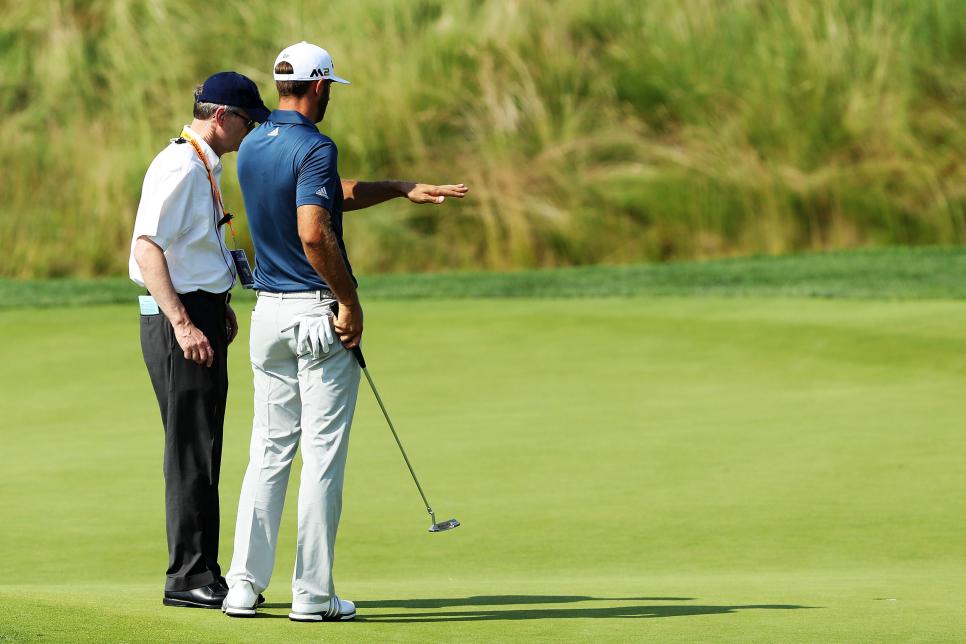U.S. Open 2024: What goes on inside the rules office at a major? We got a glimpse – Australian Golf Digest

- by Admin
- June 15, 2024

PINEHURST, N.C. — Spend time inside the USGA Rules Office at the 2024 U.S. Open and the most surprising thing you’ll encounter just might be how quiet the place is during most of the 16-plus working hours it’s in operation each day. Save for early or late in a round, when officials are checking in or clocking out, only about a half dozen people are in the facility at any one time. TVs are on in the five offices adjacent to the main room, but the volume on each is usually muted. Aside from the low hum of the air-conditioning piped into the 2,160-square-foot structure, the only noise interrupting the silence is periodic squawks from the hand-held radios that send messages between the troops in the field around Pinehurst No. 2 and back to the office located in a parking lot 1,000 yards from the clubhouse.
Thomas Pagel, chief referee of the championship and the USGA’s Chief Governance Officer, warned us. Despite the fact that this is the command center in which the 45-year-old oversees the 50-member rules committee (when Pagel isn’t out on the course himself), there isn’t a lot that suggests anything “major” is actually going on.
“You know the rules officials’ mantra,” Pagel says, “it’s hours of boredom with moments of sheer terror.”
Through two days of the 124th edition of the championship, the terror has been kept to a minimum. Which is just fine, as far as Pagel is concerned, as he reflexively knocks on his wooden desk in hopes he hasn’t jinxed himself. “Quiet is good in our business.”
Should something arise in the next two days, however, Pagel is confident he and his team are prepared. They’ve been planning for this week for the past seven months, identifying the best and brightest to work the USGA’s marquee championship and immersing them in all the nuances of Pinehurst No. 2. Those serving as rules volunteers have been trained not only to become authorities in the Rules of Golf but also in what it takes to be a good referee, how to be able to have a sensible conversation with a potentially angry tour pro—and, possibly, deliver bad news—with a TV camera staring over your shoulder and a international audience watching and listening.
Thomas Pagel is the chief referee for the 2024 U.S. Open, overseeing a 50-person rules committee this week at Pinehurst. (Photo courtesy of the USGA)
That’s not to say the Rules Office hasn’t been busy through 36 holes. During the Thursday’s first round, the rules team addressed 99 rulings, according to Pagel, involving everything from whether a ball is on a green to taking a proper drop after a ball has ended up in a spectator’s merchandise bag. During Friday’s second round, the number was 76.
The most notable of Thursday’s rulings, at least if you were following the U.S. Open on social media, came around 5:40 p.m. That’s when Bryson DeChambeau and Scottie Scheffler, across the course from each other on the fifth and 16th holes, respectively, were each dealing with instances where they were entitled to free relief from ShotLink towers on the course that were in their line of play and had been deemed temporary immoveable obstructions, or TIOs, prior to the championship. Internet rules aficionados chimed in to express contempt for how both players were taking advantage of the situation because the ShotLink towers standing in their way were hardly menacing obstacles and each wound up with far easier shot after taking their drops. DeChambeau acknowledged that he was using the rule to his benefit—which was perfectly within his right.
“Sometimes you’re lucky, and sometimes you’re not,” DeChambeau said. “In that situation, I was very lucky.”
Let’s save the discussion on the validity of the TIO relief for another day. As far as Pagel and his team were concerned, the rulings by volunteer Doug Habel with DeChambeau and Ken Tackett, a rover on loan from the PGA Tour working with Scheffler, were simple, efficient and, most important, handled by the book. Rules officials are not there to decide on the validity of the rules, but rather to enforce them and make sure they’re administered equally for all 156 players in the field. Social-media reactions aside, the rules team had done its job, as far as Pagel was concerned, and done it well.

An outside look at the USGA Rules Office at Pinehurst.
• • •
The process of assembling the rules committee for this year’s U.S. Open began in December. That’s when Pagel, along with Craig Winter, USGA senior director of Rules of Golf and Amateur Status, and other staffers in the USGA rules department started to inquiry with various allied golf associations and international golf federations about the availability of qualified volunteers to come to North Carolina the following June. Formal invitations were sent in January, all officials required to have scored 90 or higher on the USGA’s golf-standard 100-question rules quiz (the level in which one is officially deemed a rules expert), and have experience working professional golf tournaments, USGA qualifiers or other USGA amateur championships.
In the end, Pagel and Winter assembled a group that included two starters, four scoring-area officials (including two staffers from Augusta National Golf Club), 35 hole officials coming this year from the U.S., Mexico, Australia, Japan and South America, and 12 rovers, leaning here on the relationship with the PGA Tour, DP World Tour and R&A to loan out the professionals who run their competitions throughout the year. Also involved are John Bodenhamer, the USGA’s chief championships officer and the man in charge of setting up the course, along with Jeff Hall, managing director of rules and competitions.
The volunteer members of the rules committee arrived on Monday of championship week. For the next two days they familiarized themselves with the course and their specific duties for the week, aware ahead of time of their assignments. The team then assembled on Wednesday, Pagel and Winter formally addressing the particulars of the U.S. Open venue and laying out the plan for the championship.
At Pinehurst, there is just one penalty area on the entire course (water off the 16th tee that rarely comes into play). The biggest issue is bunkers and how to specifically discern where they start/end when adjacent to the sandy areas tucked throughout the course. Winter showcased an image library with photos of bunkers on several holes, complete with dotted lines to help distinguish the transition areas that might come into question.

The busiest the USGA Rules Office tends to get is when officials are checking in for duty.
Dressed in red, white and blue—red hats, white shirts and blue pants so as to be identifiable to players—the officials were ready to roll when the first round began at 6:45 a.m. Thursday. Only 27 of there 35 work at any one time, allowing them all to have half-day shifts on two of the four competition days, a blessing giving the hot conditions blanketing Pinehurst this week.
The formal process by which the officials generally are brought into play is spelled out to them on Wednesday and explained to the players in a memo each is given upon registering for the championship. If a player has a rules question, he is asked to tell his walking scorer that he’d like to speak with a hole official if one isn’t already in view. The walking scorer relays the message into the main scoring group, where someone then radios the rules team, which then summons a hole official to the scene.
This set-up has changed in recent years, the Rules Office moving away from having an individual official walking with each group to one or two officials assigned a hole and positioned in the drive zone or around the green. Says Pagel: “It’s more efficient for the committee because you really get to know your hole as opposed to stepping to the first tee and trying to remember all 18 holes.”
Typically, a player’s rules issue is addressed by the hole official in relatively short order, any delays in applying the rules mostly to clear the area of spectators. If there are lingering questions or a second opinion is needed, the rovers from the professional tours are called in to provide assistance. (The rovers are also the group that helps try to manage pace of play throughout the championship.) If more clarity is required, that’s when the Rules Office potentially gets involved. Such instances, however, are rare, Pagel saying that on average he engages with the rovers on specific rulings four or five times a day.
After every interaction with the player, regardless of the extent, the officials are asked to go on their phones and log in the occurrence, which is fed into a central Google document Pagel reviews regularly and uses as a tool for the remainder of the championship.
“At the end of the day, I’ll summarize this but in real time I can monitor it so I can see if there is a certain hole that is creating issues for us that we need to be mindful of,” Pagel says. “Maybe we need to reposition somebody if a ruling continues to re-occur.”
More From Golf Digest  history lesson The best round in U.S. Open history might not actually be Johnny Miller’s 63, according to this stat
history lesson The best round in U.S. Open history might not actually be Johnny Miller’s 63, according to this stat  Instruction U.S. Open 2024: Is the ‘Rory bounce’ real? I ran a Pinehurst experiment to find out
Instruction U.S. Open 2024: Is the ‘Rory bounce’ real? I ran a Pinehurst experiment to find out  U.S. Open 2024 U.S. Open 2024: Tiger Woods misses cut at Pinehurst, says future in championship unclear
U.S. Open 2024 U.S. Open 2024: Tiger Woods misses cut at Pinehurst, says future in championship unclear
• • •
Simultaneous to what’s taking place on the course, a separate process is underway in a smaller trailer across from the Rules Office. That’s where Winter and a handful of rules staff spend their day on video duty. This group is monitoring in real time the video feeds that are broadcast to the viewing public, proactively watching in hopes of communicating to the hole officials in real time if there’s an issue that needs to be addressed.
“If somebody’s at their living room at home and watching something, we would have liked to have already reacted to it by the time it happens,” Winter says. “Whether that’s preventing a penalty or helping a rules official [apply a rule], there are a lot of reasons we might use our eyes here to make sure the competition is fair across the field.”
The proactive monitoring of video is a change in the process that began in 2018. It was implemented shortly after the USGA and R&A publicly stated they would no longer answer inquiries from viewers at home, whether via phone or email. Instead, the governing bodies took the stance that tournament organizers should handle the responsibility of watching the video themselves. In the case of its events, the USGA created its current system where its own rules officials monitor the video, supplementing the officials working on the course.
While Winter and his group have access to footage taken by every camera on the property, the real-time review process does not involve literally watching every camera all at once but rather the main broadcast feeds shown to the public. Any additional footage is retrieved when needed after a specific issue arises in which players and hole officials would like a second look at. It’s also relied on when those on the ground are trying to help identify where a ball might have landed that is still being searched for.
In the video trailer, one official sits in a small room, headset on and at the ready to appear on the television broadcast to help explain any rulings that are being addressed and shown on TV.
“There are not many moments,” Winter says, “but when it happens, it happens in a flash.”
• • •
Not surprisingly, the process in place has evolved over time, with much of the present structure set in motion in the wake of the most controversial ruling in recent U.S. Open history. That took place in 2016 at Oakmont during Sunday’s final round when tournament leader Dustin Johnson was eventually penalized one shot after it was decided he had caused his ball to move on the fifth green—a ruling that took several chaotic hours to sort out after an initial decision by the rules official on the hole was that no violation had occurred. Subsequent viewing by members of the rules committee, however, caused others to determine Johnson had been the source for the ball’s movement when he grounded his club. Johnson played the final round with the specter that he might or might not be hit with the penalty. When he ended the day four shots clear of the trio in second place, the added shot applied before he signed his scorecard fortunately did not change the outcome of the championship.

The Dustin Johnson incident at Oakmont during the 2016 U.S. Open caused the USGA to reevaluate its rules processes.
Getty Images
“In my professional career, that was the single biggest growing moment for me personally but also for us as an organization,” Pagel says. “The No. 1 thing we’ve changed, is really the chain of command.”
Indeed, that’s when the position of the chief referee was established and protocols were put in place to allow for a swifter decision-making process, if necessary. “If something is coming down to the gun and we don’t have time to discuss it as a committee, I’m going to make the decision,” Pagel said. “And I will be responsible for that decision.”
Additionally, several structures have been added around the course with video monitors similar to the one in the video trailer that allow rules committee members to review videos and make quicker decisions.
Another thing that the Rules Office has to its advantage now is a more simplified rules book. When the Rules of Golf was updated in 2019, the modernized rules streamlined many of the ambiguities that created issues during the championship. What to do if a ball moves on a putting green, a la the Johnson-Oakmont incident, no longer requires finding out the source of the movement; the rules now allow players to replace their ball under almost all circumstance with no penalty—and no drama. And with players now allowed to remove loose impediments, the only issue when a player is in a bunker if to make sure they aren’t grounding their club.
By and large, PGA Tour pros are familiar with the Rules of Golf. But given what’s on the line in a week like this—$4.3 million to the winner, not to mention the life-changing ability to call yourself a major-championship winner—it’s only natural for them to seek out rules officials in any instance that a question might arise.
“I think that players definitely rely on rules officials. And it think that’s a good thing,” Pagel says. “The players are out there and they just want to make sure they get it right. And so even if it were their ball is on a sprinkler head, I would say 156 of them of the 156 players in this field know exactly what the rule is, know what the relief is. But they just want to make sure they’re getting it right so they’ll call for an official.”
The bottom line is that nobody wants a rules issue to impact the outcome of the championship; golf’s history book already is filled with more than enough of those instances. Everybody—players and officials alike—is hoping things stay quiet and that the only drama taking place is the stellar play of the golfers on the course.
Still, should something happen, Pagel is confident his group is organized to face the challenge and prepared for the moment. If and when any terror arrives, they’re ready.
MORE GOLF DIGEST U.S. OPEN COVERAGE
U.S. Open 101: Answering all your frequently asked questions
How to watch the 2024 U.S. Open
Power Rankings: Every player in the U.S. Open field, ranked
Video: Every hole at Pinehurst No. 2
The scariest green at Pinehurst, explained
Is the USGA going to set up Pinehurst extra hard because of recent low scores in majors?
Tiger is playing Pinehurst on a special exemption. Here’s what it is and why he got it
What would you shoot at the U.S. Open? Our new tool will tell you
U.S. Open anchor sites are about far more than golf
The U.S. Open champion who died in a jail cell
The USGA is about to play its 1,000th championship. The best 9 stats from the first 999
Payne’s Pinehurst Moment: An oral history of the 1999 U.S. Open
This article was originally published on golfdigest.com
The Latest News
-
November 15, 2024Kyrgios confirmed to return to ATP Tour at Brisbane International 2025
-
November 15, 2024Australian bounce India’s arch-enemy amid KL Rahul dilemma
-
November 15, 2024Nick Kyrgios set to make long-awaited return to tennis as comeback date revealed
-
November 15, 2024List wins elusive DP World Tour card, Barron loses his
-
November 15, 2024India great warns ‘the king is back in his territory’ as struggling Virat Kohli returns for fifth tour





